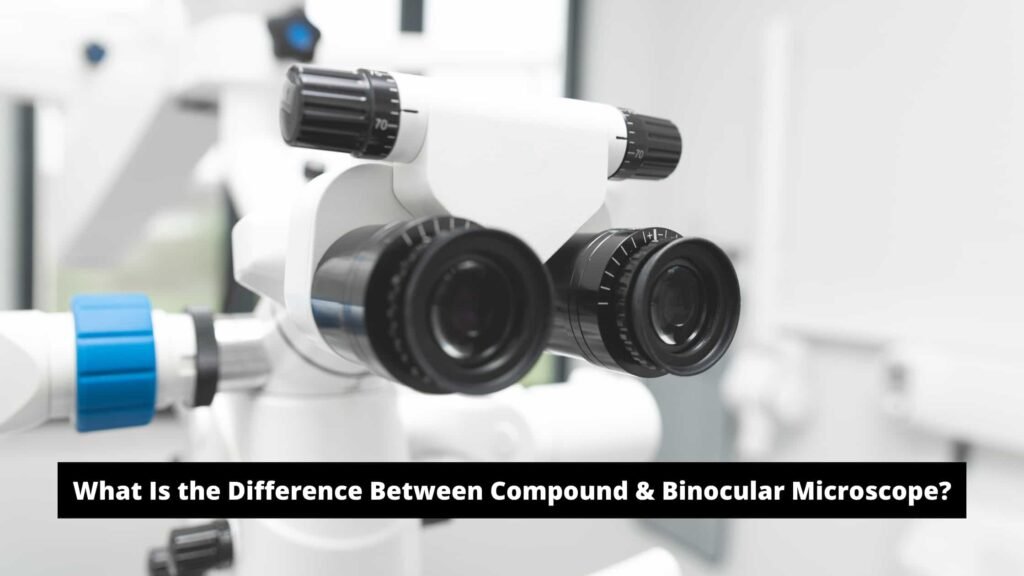Ask any research scientist what one tool of the trade they never leave home without. Go ahead and do it. We’ll be patient. You already know the answer. What exactly is it? Is that a microscope? We were thinking the same thing.
“Why don’t we talk about microscopes today?” we reasoned. An overview of Compound microscopes, in particular. What distinguishes them from one another? Do they come in a variety of styles? What are they used for, and why are they used?
So… shall we?
An Overview of Compound Microscope
The definition of the term compound, according to the dictionary, is “composed of two or more elements.” assuming that the microscope you have in your possession has two or more lenses.
There are two types of lenses in a compound microscope. The major magnification is provided by the ocular and objective lenses. Unfortunately, using this type of microscope will not provide you with 3d visual information. If you thought that was bad enough, you’ll be much more upset to realize that the photos created are almost always backward or upside down.
They are most commonly found in occupations that need in-depth investigation since they typically provide higher magnification and resolution.
Compound microscopes are used mostly by –
- When studying minerals and metals
- Biologists when examining plant cells
- Law agencies when solving crime
- For education purposes
- Virologists studying the microbial world of viruses and bacteria
Types of the Compound Microscope
- Toy Microscopes
You can find them in toy stores or places that don’t specialize in microscopical items. Sorry, I’m not sure what you’re asking. How will you tell the difference between a toy microscope and any other microscope? It’s not difficult to spot a toy microscope because they generally come with glitzy attachments that exclusively appeal to children.
And believe us when we say that if you’re serious about investing in a microscope, you don’t want to buy this one. Unless you’re purchasing it for your child, of course. Focusing is always difficult, resolutions are typically low, and brightness is non-existent.
- Education Microscopes
These are the microscopes you should choose if you’re still fresh to the game. They are inexpensive, portable, and simple to operate. Furthermore, because some of them are battery-operated, you won’t have to worry about running out of electricity.
- Laboratory Microscopes
They are slightly heavier and larger than the other two. The mechanical stage, revolving nosepiece, and Kohler-illumination condenser are some of their unique features. A laboratory microscope, which includes a binocular head that allows for prolonged observation, can also be valuable to a learner.
An Overview of Binocular Microscope
An operating or binocular microscope is an optical instrument that provides stereoscopic vision as well as a high-quality enlarged and lighted image of the surgical region’s minute features. Microsurgery is usually performed with a surgical microscope. Since the first recorded use of the binocular microscope during surgery, the operating microscope has evolved from a novel concept to a critical instrument. It was quickly adopted by many surgeons across the world due to its high stereoscopic magnification and illumination of the operation bed.
The surgical microscope’s entrance into the operating theatre began a new chapter in the history of microsurgery. It pushed the field’s boundaries, improved patient outcomes, and paved the way for subspecialties to emerge.
The design of every surgical microscope is a key element. The technology is meant to allow the surgeon to focus completely on the surgical procedure while being comfortable and free of eye strain. The microscope’s design also frees the surgeon’s hands to operate. The majority of microsurgical operations are performed in small spaces or through narrow gaps, and in these situations, the surgeon must maintain adequate binocular vision in the recesses of the area. In these situations, the binocular surgical microscope’s stereoscopic perspective is the most significant aspect of the technology.
The binocular microscope has two main functions: magnification and illumination of the operative field. The binocular microscope’s primary goal is to improve the surgeon’s visual perspective through magnification, lighting, and resolution. The binocular microscope is a high-tech device that needs to be maintained on a regular basis.
The binocular microscope reduces issues like weariness, neck aches, eye strain, and posture-related issues that result from standing for lengthy periods of time during traditional procedures. The gadget might be big and take up a lot of room, and it also necessitates regular and thorough maintenance.
Folks, till next time
But, before we depart, we’d like to remind you that investing in a lower-quality brand is a huge mistake. You’ll save money in the short term, but you’ll end up paying a lot of money, in the long run, replacing worn-out parts or upgrading. It’s not worth it, to be honest. Choose a reputable brand. You may have to dig deep into your pockets, but it will be well worth the effort.
Thanks for reading!
People Usually Search Keywords: Microscope Manufacturers | Laboratory Microscope | Microscope Manufacturers in India | Microscope Supplier | Microscope Suppliers in India | Laboratory Microscope Suppliers | Microscope Manufacturers in Ambala | Microscope India | Best Microscope Manufacturers | Microscope Ambala | Microscope Online India | Microscope Brands in India | Microscope Companies in India | Microscope Online Shopping India | Top Microscope Brands in India | Indian Microscopes | Microscope India Suppliers | Top Microscope Manufacturers | Best Microscope Brands | Best Microscope Companies | Microscope Brands | Microscope Companies | Microscope Vendors
What Is a Binocular | Binocular Microscopy | Binocular Microscope | Binocular Microscopes | Binoculars Microscope | Microscope Binocular | Uses of Binocular Microscope | Binocular Microscope Principle | Microscope Comments | Microscope Definition Biology | Define Binocular | What Is Binocular
Uses of Microscope | What Is Microscope | 10 Uses of Microscope | Uses of Lenses in Our Daily Life | Explain Microscope | Define Microscope | 5 Uses of a Microscope | Convex Lens Uses in Daily Life | What Are Its Uses | Purpose of Microscope | Application of Simple Microscope | Use of Simple Microscope | Uses of Simple Microscope | Use of Microscope | Application of Microscope | Uses of Lens in Daily Life
Who Discovered Microscope | Who Invented Microscope | Who Invented the Microscope in 1666 | Zacharias Janssen Microscope | Who Discover Microscope | Who Made the Microscope | Microscope Invented by | Who Invented Compound Microscope | Who Invented the Microscope and When | Microscope Inventor Name | Who Founded Microscope | Microscope in Kannada
What Is a Compound Microscope | Compound Microscope Comments | Compound Microscope Information | Compound Microscope | Compound Microscope Explanation | Discovery of Compound Microscope | Why Is Light Microscope Called a Compound Microscope | Types of Compound Microscope | Compound Microscope Practical | Describe Compound Microscope | About Compound Microscope | Which Lens Is Used in Compound Microscope | Comments on Compound Microscope | Components of Compound Microscope | Explain Compound Microscope | History of Compound Microscope | Study of Compound Microscope




